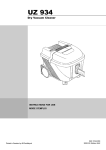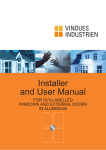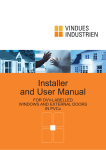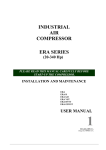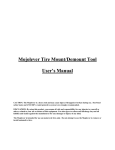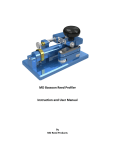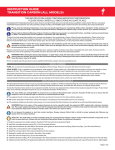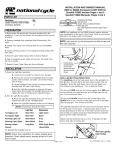Download Technical Information - Multiquip Service & Support Center
Transcript
Technical Information Product Group: TRAILERS Model: ALL MODELS This bulletin is provided for technical reference and service related updates. If you have any questions, comments or do not wish to receive these e-mails, please reply to this e-mail or call the Service Technical Support Group 800 478-1244. 3 TRAILER INSPECTION SERVICE TRAILER INSPECTION AND SERVICE Always Inspect safety hooks for damage before leaving yard. Inspect all lights for proper operation. Verify all documents are up to date and in the document box. Verify the ball hitch on the trailer matches the ball on the tow vehicle. Inspect trailer for loose or damaged components and fasteners. RUNNING GEAR INSPECTION AND SERVICE Always make sure the tires on your trailer are inflated to the proper air pressure as specified by the tire manufacture. Check wheel fastener torque frequently. Each time a wheel is removed and re-mounted, the lug nuts should be checked and re-tightened after ten (10) miles, twenty five (25) miles and fifty (50) miles and periodically thereafter. Use the proper wheel fastener and torque range as specified by the wheel manufacturer. Excessive torque can permanently damage the wheel while insufficient torque can result in stud failure. Remember to inspect and service wheel bearings regularly as stated in your Operation & Maintenance Service Manual. Use the proper bearing adjustment method as stated in your Operation & Maintenance Service Manual to assure reliable, long life performance. Wheels and tires must be properly matched to each other to ensure safe, reliable performance. Do not exceed the capacity of your trailer's running gear. Overloading can seriously degrade the life of the various components, result in unsafe braking and may lead to catastrophic failure. When using after-market wheels, make sure that they fit properly and that the wheel studs are long enough to ensure proper thread engagement. Remember to have your tires rotated and balanced according to the tire manufacturer's recommendations. Check your brakes before every use to make sure they are functioning properly. It is very important to pull your trailer so that it is running level. If the hitch is too high or too low, the trailer axle(s) may be unevenly loaded and can result in either a tire or axle failure. Inspect your emergency breakaway devices to make sure they are in good working order before each use. TI_Trailer_Inspection_Service 1 07/03/2013 Technical Information When loading your trailer, make sure enough weight is being carried on the hitch to ensure proper weight distribution and good handling. Never fix an air leak in your wheel by putting a tube in the tire. The only safe solution for a leaky wheel is to replace it. Remember to use recommended safety tools, personal protection, and procedures when servicing your trailer. Follow the trailer manufacturer's guidelines for lifting and supporting trailer when servicing running gear. Never use the axle or suspension as a jack point to lift the trailer. Use caution when servicing brakes since, some lining materials can contain asbestos. Remember to lubricate the moving parts in your brake per the manufacturer's recommendations. Proper maintenance will prevent them from seizing up. Do not allow grease or oil to contaminate the linings, magnet, or drum surfaces. The Gross Axle Weight Rating (GAWR) of your running gear is determined by the lowest rated component in the assembly. The capacity of the wheel, tire, axle, brake, springs/rubber and hub are all considered. The location of the load on a trailer will affect the ride characteristics. Too little load on the hitch can cause the trailer to wander or sway. Too much hitch load can overload your towing vehicle's suspension. If you experience uneven tire wear, it is important to note the type and nature of the wear pattern in order to determine the cause. Contact your tire dealer to assist in troubleshooting the problem. Make sure there is enough clearance around the sides and top of the tires to prevent the tire from rubbing on the frame or other trailer structure. Oil lubricated bearings are best suited for trailers that are used continuously. Grease will provide better protection for bearings during long periods of storage. Axles fitted with Dual wheels should never be operated with only one wheel in place or with one of the two tires flat. Doing so can seriously overstress the wheel bearings and result in bearing failure. Mixing aluminum wheels and steel dual wheels will result in galvanic corrosion between the two dissimilar metals. This corrosion can cause wheels to loosen and possibly result in stud failure and wheel run-off. Replace brake shoes if the linings have been contaminated with oil or grease, are less that 1/16" thick, or are abnormally scored or gouged. Minor cracks in linings are not detrimental unless chunks of the linings are missing Remember that your new brake shoes need to be burnished or "seated in". This process may take quite a few stops to get the shoes fully worn in before maximum brake performance can be achieved. TI_Trailer_Inspection_Service 2 07/03/2013 Technical Information TRANSPORTING A TRAILER Transporting trailer on flat bed Axles: o It is recommended to use wheel tie down straps. o Not recommended using straps over tube of axle. Frames: o Frames have four tie-downs to secure frame evenly. o Keep trailer frame level when securing to flat bed. o Do not over tighten straps/chains causing frame stress. TIE DOWNS Some tie downs are V shaped and others are D shaped TOWING A TRAILER Perform a safety inspection before each trip. Make sure that: The pin securing the ball mount to receiver is intact. The hitch coupler is secured. Spring bar hinges are tight with safety clips in place. Safety chains are properly attached. The electrical plug is properly installed. Trailer is level at all times by appropriate tie downs during travel. NOTE: Pulling a trailer on an angle puts extra stress on frames and may lead to frame cracks and failure. Contributing Credit: Dexter Axle • www.dexteraxle.com TI_Trailer_Inspection_Service 3 07/03/2013 Technical Information TRIP PREPARATION CHECKLIST There are a number of simple rules to follow in caring for you trailer assembly that can add to its life and in the case of some of these rules, you may be protecting your own life as well as others. Using the following checklist before starting a trip with your trailer is highly recommended. Some of these items should be checked 2-3 weeks prior to a planned trip to allow sufficient time to perform maintenance. Check you maintenance schedule and be sure you are up-to-date. Check hitch, is it showing wear? Is it properly lubricated? Fasten safety chains and breakaway switch actuating chain securely. Make certain the breakaway battery is fully charged (if it has one). Inspect towing hookup for secure attachment. Load your trailer so that approximately 10% of trailers total weight is on the hitch. For light trailers this should be increased to 15%. Do Not Overload. Stay within your gross vehicle rated capacity (consult your trailers identification plate). Inflate tires according to manufacturer’s specifications; inspect tires for cuts, excessive wear, etc. Check wheel mounting nuts/bolts with a torque wrench. Torque in proper sequence. Make certain the brakes are synchronized and functioning properly. Check tightness of hanger bolt, shackle bolt, and U-bolt nuts. Check operation of all lights Check that your trailer is towing in a level position and adjust hitch height if required. NOTE: Some trailers may have options that are not mentioned on this list, if you are not familiar with the options, ask questions, be informed, don’t assume. For more comprehensive trailer information please refer to the MQ Trailers Owner’s Manual. TI_Trailer_Inspection_Service 4 07/03/2013 Technical Information AXLE REPLACEMENT AND SERVICE Trailers equipped with torsion axles must be towed in a level attitude to ensure even loading on the axles. Out of level towing can result in higher loads being imposed on the axle at the low portion of the frame and less load on the axle(s) at the high end. This uneven load distribution may cause excessive stress concentration on the frame structure. Uneven loading of non-equalized suspension can also affect the ride characteristics by altering the natural frequency of the structure. When using torsion axles on trailer frames, it is important to understand the compressive stresses imposed by the fasterners. Yielding in these areas can lead to loosening of the axles and could result in fatigue failure of the axle bracket and tube structure and/or the frame members. If aluminum materials are to be used between the mating surfaces to prevent galvanic corrosion, you must consider the stability of these materials under the high clamp loads. Extrusion of these materials under load may also lead to loosening of the axle attachment. When replacing axles, torsion axles will be subject to higher stresses at the bracket/tube as a result of frame racking. Racking occurs when the vehicle travels over uneven surfaces and the loads imposed at each wheel are substantially different If the torsional stiffness of the vehicle structure is relatively low, the areas where the cross members are joined to the main frame rails and the axle bracket/tube welds must withstand the twisting the occurs in these critical regions. Excessive flexing may result in fatigue failures. To reduce the potential for problems due to racking, position the axles close together. Torsion axle ride performance is at its best when the torsion arm is at or nearest to horizontal when the vehicle is at its rated load. This is due to the geometric relationship of the arm to the direction of loading. Torsion arms operating above the horizontal tend to exhibit a stiffer ride. As an example, for a 3000 lb. wheel load perpendicular to a 6” long arm, the torque input of the suspension system is 18,000 inch pounds. For the same wheel load imposed on a 6” long arm at 45 degrees, the torque input to the suspension drops to 12,727 inch pounds. (Torque = 6(.707) x 3000, since the sine of 45 is .707). CENTER OF THE AXLE: Measure the distance from the center of the hitch to the center of gravity, (dim. A). Divide the value by the percentage of the load to be carried by the running gear. The result will be the distance from the center of the hitch back to the center of the axle set, (dim. B). TI_Trailer_Inspection_Service 5 07/03/2013 Technical Information Spring eyes and equalizers must be free to rotate. Binding can lead to unsatisfactory ride performance and possible spring failure To ensure proper tracking, the axle must be placed on the frame perpendicular to the centerline of the vehicle. The accuracy must be within plus or minus one half degree. For multiple axle applications, each axle must be parallel with the others within sixteenth of an inch when measured at the wheel. NOTE: when laying out the position of the axle(s), measuring from front to cross members should only be done if the cross member has been checked for squareness to the frame centerline. Any error in the cross member will be transferred to the axle and can result in poor tracking and excessive tire wear. Contributing Credit: Applications Manual • Dexter Axle • www.dexteraxle.com TI_Trailer_Inspection_Service 6 07/03/2013






